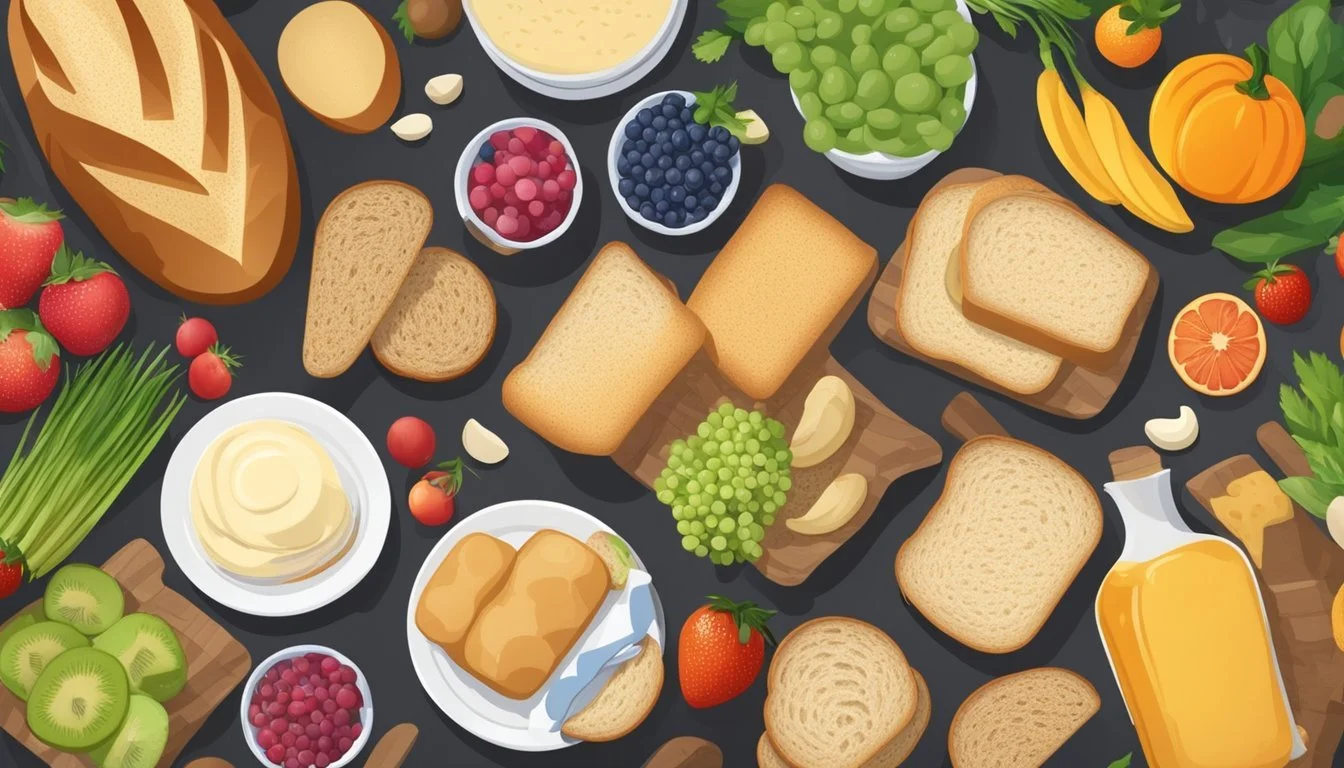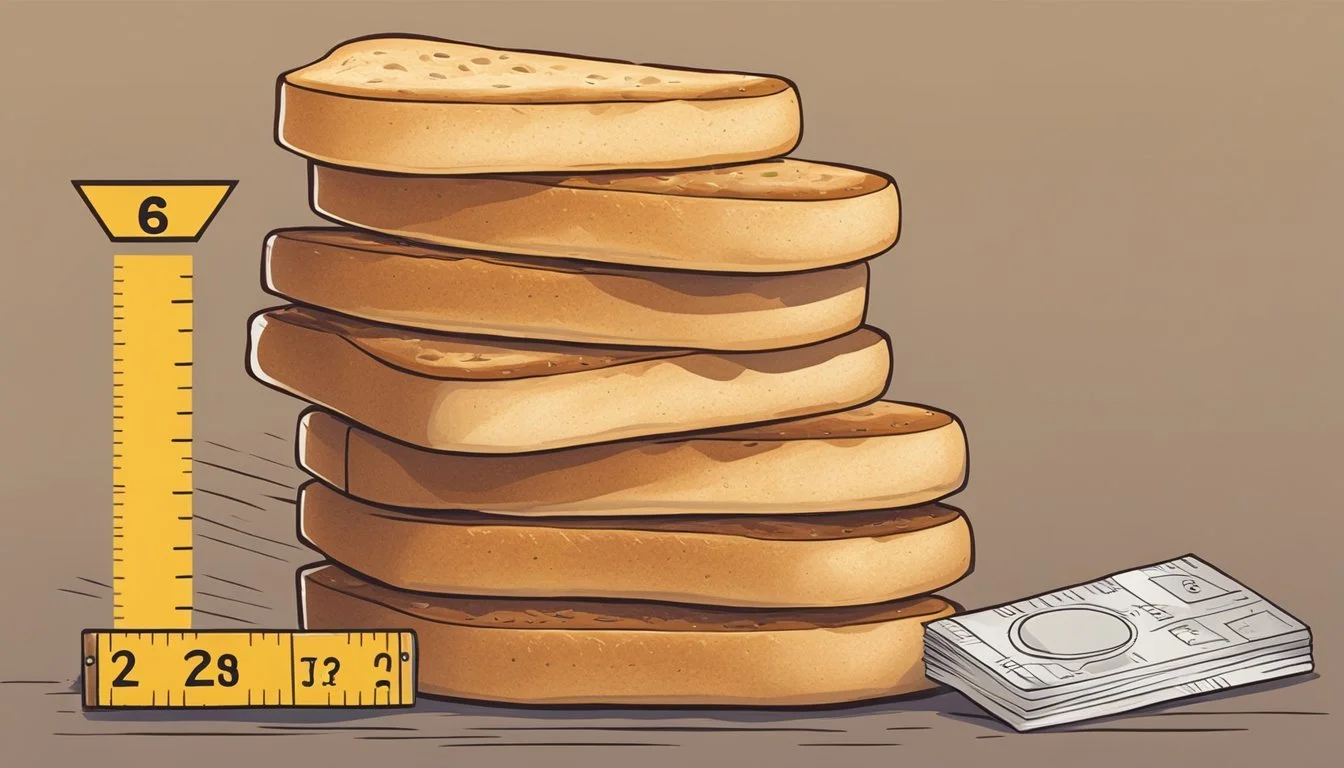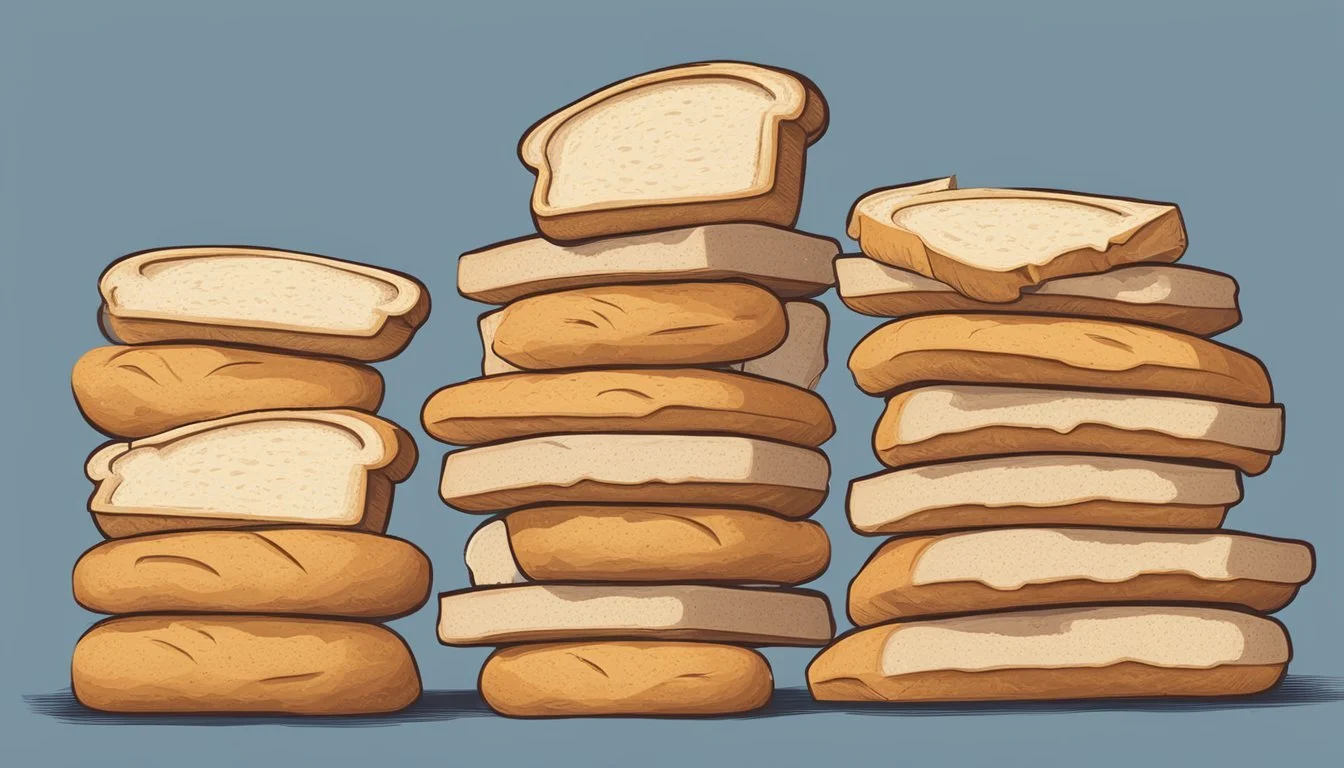How Many Slices of Bread Per Day Is Too Much?
Understanding Healthy Portions
Bread is a staple in many diets around the world, valued for its convenience, versatility, and taste. It's a significant source of carbohydrates which, when consumed in moderation, can be a beneficial part of a balanced diet. The appropriate quantity of bread intake varies depending on an individual's age, sex, and level of physical activity. Moderately active women between the ages of 19 to 50 are recommended to consume about six servings of grains a day, which includes bread, while those above 50 should target five servings. In contrast, moderately active men aged 19 to 30 may require up to eight servings, while those over 30 might need fewer.
The amount of bread one should eat can also be influenced by dietary goals and overall health considerations. Grains, including bread, are part of a group of essential foods that provide the body with energy, fiber, and nutrients such as B vitamins and iron. However, the type of bread consumed also plays a significant role in its health impact. Whole grain breads, for example, are often recommended over white bread due to their higher nutrient content and fiber which aids in digestion and can help in maintaining stable blood sugar levels.
Understanding the balance in grain consumption, particularly for bread, requires a consideration of one's entire diet. While guidelines provide a general framework for the recommended servings—such as two to four slices of bread per day for adults—individual needs can vary. Portion sizes and the type of bread incorporated into one's diet are pivotal factors to ensure that bread consumption contributes positively to one's overall nutritional intake without exceeding daily caloric needs.
Understanding Bread Consumption
The amount of bread one should consume daily is a function of their individual dietary needs and the type of bread they choose. This section breaks down the elements affecting bread consumption, focusing on the variety of bread, its role in a balanced diet, the nutritional content, and its impact on energy levels.
Types of Bread
There are various types of bread available, ranging from white and whole wheat to multigrain and sourdough. The healthiest options are whole grain breads, which contain the entire grain kernel, preserving fiber, vitamins, and minerals. White bread, on the other hand, made from refined flour, lacks these nutrients because the bran and germ of the grain are removed during processing.
Role of Bread in the Diet
Bread serves as a significant source of carbohydrates in many diets across the globe. Carbohydrates are essential for energy, and when consumed as part of a balanced diet, bread can help meet daily caloric and nutritional requirements. The fiber content, particularly in whole grain variations, is beneficial for digestion and can contribute to satiety, reducing the likelihood of overeating.
Nutritional Profile of Bread
The nutritional value of bread varies widely:
Calories: Generally range from 60 to 120 per slice, depending on the type and ingredients.
Carbohydrates: Essential for energy, could range from 12 to 20 grams per slice.
Fiber: Varies greatly, with white bread offering less than 1 gram per slice and whole grain providing 3 grams or more.
One should always refer to the product's nutritional label for accurate serving size and content.
Bread and Energy Levels
Bread's carbohydrate content directly influences energy levels. Whole grain breads offer a more complex carbohydrate which translates to a steadier release of energy, while white bread, being high on the glycemic index, may lead to quick spikes and subsequent drops in blood sugar levels. A moderate consumption tailored to one's lifestyle and energy demands is crucial for maintaining balanced energy levels throughout the day.
Health Considerations
Understanding the health considerations of bread consumption is key to maintaining a balanced diet. This includes recognizing the effects of excess intake, its impact on digestive health, potential connections to chronic diseases, and how it fits into special dietary requirements.
Effects of Excess Bread Intake
Excessive consumption of bread, especially refined white bread, can lead to various health issues such as weight gain and erratic blood sugar levels, which are risk factors for diabetes. Health professionals generally advise moderation to avoid these negative impacts.
Bread and Digestive Health
Incorporating bread into one’s diet requires careful consideration of digestive health. Whole grain bread can be beneficial due to its fiber content. However, for individuals with celiac disease or gluten sensitivity, gluten-containing bread can cause significant harm to the digestive system, necessitating gluten-free options.
Bread and Chronic Diseases
The relationship between bread consumption and chronic diseases is a subject of continual research. Some studies suggest that a high intake of refined grains might be linked to an increased risk of heart disease. Dietitians often recommend whole grain alternatives to lower this risk.
Special Dietary Requirements
Individuals with specific health conditions must adjust their bread intake accordingly. For example, those with diabetes benefit from choosing bread with a low glycemic index to maintain stable blood sugar levels. For weight management or certain health conditions, the advice of a dietitian is invaluable to tailor bread consumption to individual needs.
Nutritional Guidelines
When considering how many slices of bread to include in a diet, individuals should focus on guideline-based servings, the balance with other foods, and the choice of healthier bread options.
Recommended Bread Servings
The U.S. Department of Agriculture (USDA) structures dietary recommendations by servings. For grains, this includes bread. One serving equates to roughly one ounce. Here's how it breaks down for different groups:
Moderately active women (19-50 years): 6 servings of grains per day
Women over 50: 5 servings per day
Moderately active men (19-30 years): 8 servings per day
Men (31 years and older): 6-7 servings per day
These are general guidelines and may vary based on an individual's specific calorie needs and levels of physical activity.
Balancing Bread with Other Foods
A healthy diet isn't just about how much bread one consumes but also how it fits into the overall consumption of other food groups.
Vegetables, fruits, proteins, and dairy: Each have their own recommended servings within a diet.
Grain group: Should be balanced with these other groups, ensuring dietary fiber and essential nutrients are met through a varied dietary intake.
Choosing Healthier Bread Options
When selecting bread, it's not only the quantity but also the quality that counts towards a healthy diet.
Whole-grain options: Preferable over white, refined choices as they provide additional dietary fiber and nutrients.
Labels: Look for "whole grain" as the first ingredient and be wary of terms like "multigrain" or "wheat flour" which might not indicate a truly whole-grain product.
Remember, specific needs can vary greatly depending on factors like age, gender, physical activity, and health goals.
Types of Bread and Their Impact
When considering how many slices of bread per day one should consume, it's critical to understand the different types of bread and their nutritional profiles. These can greatly affect the impact bread has on one's diet.
Whole Grain vs. Refined Grains
Whole-wheat bread is made from grains that have retained all components of the grain kernel (the bran, germ, and endosperm), which means it generally has more fiber and nutrients than its refined counterparts. White bread, typically made from refined wheat flour, lacks the bran and germ, resulting in fewer nutrients and a higher glycemic index, which can affect blood sugar levels more dramatically.
Nutritional comparison per slice:
Whole-wheat bread typically contains about 92 calories and offers a higher amount of fiber and nutrients.
White bread usually has about 67 calories per slice and offers less nutritional value due to the refining process.
Gluten Content in Bread
Gluten is a protein found in wheat, rye, and barley, and it gives dough its elasticity and final chewy texture. Sourdough bread, made through a fermentation process, may be easier to digest for those with slight gluten sensitivities, though it is not gluten-free. Gluten-free bread substitutes traditional wheat flour with alternative flours for those with celiac disease or gluten intolerance.
Gluten content comparison:
Sourdough bread: May contain lower levels of gluten due to the fermentation process.
Gluten-free bread: Made without gluten-containing grains; safe for individuals with celiac disease or a gluten intolerance.
Bread Alternatives
For those seeking alternatives to traditional bread, options such as wraps, flatbreads, and grain-free breads provide variety and may offer different nutritional benefits. Alternatives made from almond flour, coconut flour, or other gluten-free flour blends cater to specific dietary needs without sacrificing the ability to enjoy bread-like products.
Alternative options:
Wraps and flatbreads: Can be made with refined or whole-grain flours and offer a versatile form different from traditional sliced bread.
Grain-free and gluten-free breads: Use various alternative flours, reducing carbohydrate content and providing options for those avoiding grains or gluten.
Incorporating Bread into a Balanced Diet
Bread can be part of a nutritious diet, providing energy and nutrients. It's important to balance its intake with other food groups and consider the individual's activity level.
Creating a Nutritious Meal Plan
When planning meals, individuals should aim for diversity in their grain intake to ensure they receive a broad spectrum of nutrients. They should include a variety of whole grains beyond white bread, such as whole wheat, oats, and barley. A nutritious meal plan considers the appropriate portions of grains based on age, gender, and physical activity levels. For example, moderately active men and women may require different servings of grains. According to the USDA, six servings per day are recommended for moderately active women aged 19 to 50, while men aged 19 to 30 should aim for eight servings.
Suggested Grain Servings Based on Age and Gender:
Women (19-50 years): 6 servings/day
Women (>50 years): 5 servings/day
Men (19-30 years): 8 servings/day
Men (>30 years): Varied based on activity
Combining Bread with Other Food Groups
Bread can serve as a vehicle for consuming other healthy food groups. When consumed, it's important to complement bread with adequate vegetables, fruits, proteins, and sources of healthy fats to form a balanced meal:
Pair a slice of whole-grain bread with:
A serving of lean protein (chicken, fish, beans)
A variety of colorful vegetables (leafy greens, tomatoes)
A fruit serving for added vitamins
A spread of healthy fat (avocado, olive oil)
This approach ensures that while bread is included in the diet, it's part of a greater nutritional context. Individuals should also tailor their consumption to align with their physical activity levels to balance caloric intake with energy expenditure.
Consumer Advice
When deciding how much bread to consume daily, consumers should prioritize quality and understand the nutritional content. Bread can range widely in terms of health benefits, so selecting the right type and understanding its ingredients are crucial steps.
Shopping for Quality Bread
Consumers shopping for bread, whether at a supermarket or a local bakery, should look for loaves that list whole grains as the first ingredient. Whole grains have been linked to numerous health benefits, including a lower risk of chronic diseases. Breads that carry the Whole Grains Council stamp indicate that they contain at least half a serving of whole grains per slice. When available, artisanal bread from a local bakery might offer fresher ingredients and less processing, which can contribute to higher nutritional value.
Understanding Food Labels
Reading food labels is essential for consumers to manage their bread intake effectively. A registered dietitian can provide guidance on interpreting these labels and making healthier choices according to individual dietary needs. Here are some specifics to look out for:
Serving Size: Clearly defined, usually in terms of slices, this informs consumers how much bread is considered one serving.
Calorie Content: Provides information on the energy value per serving.
Nutrients: Details the amount of dietary fiber, sugars, sodium, and other key elements.
By understanding these particulars on bread packaging, consumers can make informed decisions about how much bread to integrate into their daily diet.
Health Benefits and Risks
Evaluating the appropriate consumption of bread involves understanding its nutrient content and impact on blood sugar levels. Bread, when chosen correctly and eaten in moderation, can offer several health benefits, but excessive intake may lead to health concerns.
The Importance of Nutrients in Bread
Bread can be a good source of essential nutrients when included as part of a balanced diet. Whole-grain breads, in particular, are rich in:
B vitamins: Essential for energy metabolism and numerous physiological processes.
Iron: Vital for blood production and oxygen transport.
Fiber: Important for gut health and digestion.
The nutritional profile varies significantly between different types of bread. For instance, whole-grain breads generally provide more vitamins, minerals, and fiber than white breads, which have been stripped of many beneficial constituents during processing. Choosing bread with a higher nutrient density can contribute to a better overall diet.
The Relationship Between Bread and Blood Sugar
The bread's effect on blood sugar levels is primarily determined by its glycemic index (GI). A high glycemic index indicates that the food can spike blood sugar levels quickly, which is a concern for individuals with metabolic conditions such as diabetes.
White bread: Often has a high GI due to refined flour, which can cause a rapid increase in blood sugar.
Whole-grain bread: Typically has a lower GI, promoting a more gradual rise in blood sugar.
Overconsumption of high GI breads can lead to health concerns such as increased risk of type 2 diabetes and cardiovascular diseases. On the contrary, breads with a lower GI can be part of a diet that supports sustained energy levels and overall health.
Cultural and Historical Significance of Bread
Bread, as a staple food, has had significant roles in both culture and history. This section explores bread's journey through human civilization and the evolution of bread-making techniques.
Bread in Human Civilization
Bread's importance extends beyond nourishment; it has been a symbol of shared life and prosperity. In many Western cultures and Asia, bread holds a place of reverence, intertwined with traditions and rituals. Within Christianity, it assumes a sacred role as part of the Eucharist. The term "companion" illustrates bread’s cultural imprint, deriving from Latin words that translate to "with bread," signaling its role in fellowship and community bonding. Bread's ubiquitous presence across various societies has cemented it as a cultural artifact representing sustenance and civilization.
Bread-Making Techniques Through Ages
The art of bread-making has seen profound changes over time, transitioning from rudimentary fermentation practices to sophisticated mechanized processes. Early bread-making involved simple dough preparations from cereals and grains, then left to ferment naturally, creating diverse flavors and textures. Advances in bread-making reflect human innovation, with technologies giving rise to consistent and efficient production methods. Notably, the 20th century saw the mass adoption of pre-sliced bread, streamlining convenience and uniformity in consumption. This evolution signifies how integral bread-making techniques have been in shaping dietary habits and lifestyle conveniences.
Conclusion
Determining the optimal daily intake of bread hinges on one's individual dietary needs, health goals, and the type of bread consumed. For a balanced diet, whole grain breads are preferable over white bread due to their higher nutritional content, including fiber, vitamins, and minerals.
For Adults:
Moderation is key; typically, 2-4 slices of whole grain bread align with a healthy diet plan.
Refined white bread should be limited due to lower nutritional value and potential to spike blood sugar levels.
For Children:
A range of 1-2 slices is generally acceptable, emphasizing whole grains for nutritive value.
In the context of weight management:
For those aiming to lose weight, monitoring portion sizes and opting for whole grains can contribute to a feeling of fullness and nutrient intake without excessive calories.
Well-being considerations:
A diet diverse in grains, fruits, vegetables, proteins, and fats promotes overall well-being.
Bread can fit into this diet, provided it is consumed within recommended servings and as part of a varied meal plan.
Remember, these recommendations should be adapted to align with one's personal health requirements and the guidance of health professionals.








